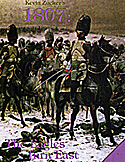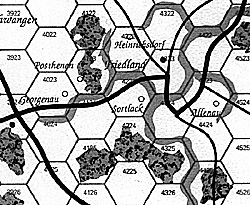 Title: 1807: The Eagles Turn East
Title: 1807: The Eagles Turn East
Designer: Kevin Zucker
Designer's Credits: Napoleon at Bay (Operational Studies Group, then Avalon Hill), 1809 (Victory Games), Struggle of Nations (Avalon Hill), The Emperor Returns (Clash of Arms) and several more.
Number of Players: 2
Playing Time: Thirty minutes or more per turn, with some Battle Scenarios as short as four turns and the Grand Scenario over 100 turns.
Complexity Level: Moderate for the standard game, slightly higher when playing Campaign and Grand Scenarios.
Packaging: Flat rectangular cardboard box with the famous painting of Colonel Lepec and his Grenadiers a Cheval at Eylau ("Haut le Tetes! Le Mitraille n'est pas de la merde!" "Hold your heads high! Those are bullets, not shit!"' adorning the top. The painting is bordered in gold and Polish Crimson. Scale: Grand strategic campaign in which units represent corps and divisions. Players take the role of either Napoleon or Bennigsen.
Map: Three 34- by 22-inch maps with a scale of one hex equal to two miles.
Playing Pieces: 420 die cut, glossy counters representing leaders, combat formations (mostly divisions, but with a few regiments and brigades), depots and information markers.
Rule Books: One standard rule book for the series and one book of rules specifically for this campaign. There is also a study folder, two organizational displays, and 12 pages of charts and tables.
Scenarios: Three Battle Scenarios (Pultusk-Golymin, Eylau and Friedland), three
longer Campaign Scenarios covering the same battles and one Grand Scenario covering the entire 1806-1807 war.
Publisher: Clash of Arms Games
ISBN: None listed.
List Price: $48.00
Summary: This is an operational (i.e., campaign level) simulation covering the
December 1806 to June 1807 struggle between the French Grande Armee under Napoleon and the Imperial Russian Army under General of Cavalry Levin Bennigsen, the latter ably assisted by the remnants of the Royal Prussian Army under Lieutenant General L'Estocq.
With 1807 - The Eagles Turn East, designer Kevin Zucker brings us another fascinating part in one of the longest running historical boardgame series. While one cannot point to anything that is particularly bold or innovative in the game, its proven and familiar system is its greatest strength.
 As with all Clash of Arms (COA) games, 1807 is graphically attractive. The maps are accurately drawn in shades of tan and brown, giving an overall antique look to the playing surface. Organizational displays use pictures of generals involved in the campaign. Leader counters are represented by the flag of the major nation he serves, with appropriate numerical data printed on the back.
As with all Clash of Arms (COA) games, 1807 is graphically attractive. The maps are accurately drawn in shades of tan and brown, giving an overall antique look to the playing surface. Organizational displays use pictures of generals involved in the campaign. Leader counters are represented by the flag of the major nation he serves, with appropriate numerical data printed on the back.
 This means the lozenge design tricolor for generals of France while leaders of Prussia and Russia make do with their familiar eagle and Maltese cross combination (black cross on white for Prussia and green cross on white for the warriors of the Czar).
This means the lozenge design tricolor for generals of France while leaders of Prussia and Russia make do with their familiar eagle and Maltese cross combination (black cross on white for Prussia and green cross on white for the warriors of the Czar).
Combat units use standard modern military symbols superimposed over a specific national color. The only exception is light cavalry units which use a Hussar braid design. Napoleonic flavor is added by the use of symbols prevalent during the period. For example, a flaming grenade is used to signify elite units. Even informational markers are creative, with my favorite being a forage counter showing a French soldier about to dispatch a rabbit
Each turn represents two days of the campaign. The specific Sequence of Play begins with a Command Phase, then follows with a Movement Phase, a Combat Phase and finally a Morale Phase. First one side completes all its operations, then the other. Logistical operations are designed as a subset of the Command Phase.
This fact is significant as the two specific aspects of Napoleonic campaigning emphasized by the rules are logistics and command-control (C2). Of the two, the laHer seems most important to success or failure.
The way the C2 system works involves something called Administration Points. Each turn an army must roll two dice to determine how many of these Admin Points it will receive for upcoming play. The die roll is modified for the distance between the Army's Headquarters (called a Center of Operations in the game) and its ultimate source of supply. The greater the distance, the less chance of receiving Admin Points.
C2 is also emphasized by the way the combat leaders themselves are handled. Each leader has a set numerical Command Span. This number represents the total number of subordinate units and leaders a commander can control, based on their individual Subordination Values. For example, Marshal Massena (Command Span of six) could control up to six infantry divisions (Subordination Value of one each). Or, he could control three infantry divisions and Marshal Davout (Subordination Value of three) with all the units Davout controls as well.
The units controlled by a leader are rarely placed on the map. Rather, they sit on the Organizational Display which records their current strength as well as under whom they are subordinate. An opposing player will thus see only a flag designed counter on the map, and not which leader that flag represents or what combat units are under his command. Only through combat with that force, or light cavalry reconnaissance will such information be discovered.
In terms of logistics, the big factor is something called March Attrition. Normally every formation must roll two dice using a table to see how many Strength Points it will lose as soldiers become ill, drop out because of fatigue, etc. The farther a Force has marched, the greater the likelihood it will lose Strength Points due to March Attrition.
Other factors include the morale of the units involved, their leadership, the weather and the use of Extended or Forced March.
Also affecting the die roll is the specific terrain the Force occupies (pasture, oats, wheat or potatoes, thus allowing the opportunity for Foraging, but at a detriment in combat power) and whether it is within range of its Center of Operations. It may seem a bit complex, but it all works.
For combat, the game uses a ratio table with column shifts and modified die rolls. There are some nice touches, such as a Pursuit Table for running your opponent into the ground, and a special Batteries Forward Rule to allow the French to aggressively handle their massed artillery as Senarmont did at Friedland.
I think Zucker was a bit too generous with Admin Points for the Russians, though this may have been a play balance device. The game also includes a Fortnight sequence of play option that allows several turns to be lumped together. It works, but I am not sure why this option is necessary. The Study Folder and the Exclusive Rules could be rewritten to come across a little less disjointed. In the latter case this is because the seemingly confused rules numbers actually refer to rules sections in the Standard Rules Folder, so be careful!
Finally, I would like to see more of these games, perhaps next time the 1815 campaign whereby the Emperor is allowed to tangle with Schwarzenberg's Austrians and Barclay's Russians as well as Wellington's and Blucher in Belgium.
I highly recommend 1807: The Eagles Turn East.

Back to Empire, Eagles, & Lions Table of Contents Vol. 2 No. 14
Back to EEL List of Issues
Back to MagWeb Master Magazine List
© Copyright 1995 by Emperor's Headquarters
This article appears in MagWeb (Magazine Web) on the Internet World Wide Web.
Other military history articles and gaming articles are available at http://www.magweb.com
